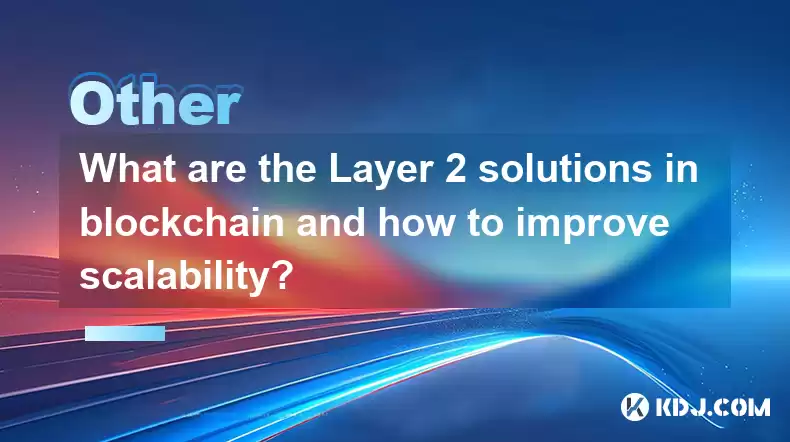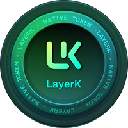-
 bitcoin
bitcoin $102877.190955 USD
1.88% -
 ethereum
ethereum $3430.435064 USD
4.52% -
 tether
tether $0.999264 USD
-0.05% -
 xrp
xrp $2.307310 USD
4.49% -
 bnb
bnb $987.740692 USD
3.82% -
 solana
solana $161.947760 USD
3.97% -
 usd-coin
usd-coin $0.999712 USD
-0.05% -
 tron
tron $0.292810 USD
2.93% -
 dogecoin
dogecoin $0.179738 USD
10.70% -
 cardano
cardano $0.580716 USD
8.75% -
 hyperliquid
hyperliquid $42.463448 USD
8.40% -
 chainlink
chainlink $15.763437 USD
7.05% -
 zcash
zcash $649.595636 USD
17.21% -
 bitcoin-cash
bitcoin-cash $511.610261 USD
7.19% -
 stellar
stellar $0.292537 USD
7.91%
ブロックチェーンのレイヤー2ソリューションとスケーラビリティを改善する方法は何ですか?
Layer 2 blockchain solutions, like state channels and rollups, alleviate Layer 1 limitations by processing transactions off-chain, thus increasing throughput and reducing fees.
2025/03/03 05:36

ブロックチェーンのレイヤー2ソリューションとスケーラビリティを改善する方法は何ですか?
キーポイント:- レイヤー1とレイヤー2の必要性の理解:ビットコインやイーサリアムなどのレイヤー1ブロックチェーンは、ブロックチェーンネットワークのコア機能を処理します。ただし、トランザクションのスループットと処理速度におけるそれらの固有の制限は、多くの場合、高い取引手数料とネットワークの輻輳につながります。レイヤー2ソリューションは、トランザクション処理の一部をメインチェーンから移動することにより、これらのスケーラビリティの問題に対処するように設計されています。
- レイヤー2ソリューションの種類:状態チャネル、ロールアップ(楽観的およびZKスナーク)、サイドチェーン、プラズマなど、いくつかの顕著なレイヤー2スケーリングソリューションを調査します。それぞれが、セキュリティ、分散化、複雑さの点でさまざまなトレードオフでスケーラビリティを改善するための異なるアプローチを提供します。
- レイヤー2でスケーラビリティを向上させる:各レイヤー2ソリューションの背後にある技術的メカニズムを掘り下げ、メインチェーンの負担を緩和し、最終的にトランザクションスループットを増やし、料金を削減する方法を説明します。また、レイヤー2スペース内で進行中の開発と革新についても説明します。
- 適切なレイヤー2ソリューションの選択:最適なレイヤー2ソリューションは、特定のニーズと優先順位に依存します。考慮すべき要因には、必要なセキュリティのレベル、目的のレベルの地方分権化、実装の複雑さ、およびサポートされているアプリケーションのタイプが含まれます。
- 状態チャネル:
自分自身の間で繰り返し取引したいと思っている人々のグループを想像してください。すべてのトランザクションをネットワーク全体にブロードキャストする代わりに(レイヤー1では高価で遅い)、ステートチャネルを開くことができます。このチャネルは、参加者間でトランザクションが記録されるプライベートオフチェーン元帳のように機能します。チャネルの最終状態(すべてのトランザクションの最終結果)のみが、レイヤー1ブロックチェーンに書かれています。これにより、メインチェーンの負荷が大幅に削減されます。このプロセスにはいくつかのステップが含まれます。
* **Channel Opening:** Participants agree to open a state channel and deposit funds into a multi-signature smart contract on the Layer 1 blockchain. This contract acts as an escrow, holding the funds until the channel is closed. The initial state of the channel is recorded, showing the initial balances of each participant. This requires a Layer 1 transaction, but it's a one-time cost. The smart contract's code is carefully audited to ensure its security and correctness, mitigating the risk of fraud. The selection of participants is crucial, and the initial state must be meticulously verified by all parties involved. The security of the entire channel relies on the correctness of the smart contract and the honest participation of all parties. Any vulnerabilities in the smart contract or malicious behavior by participants can compromise the security of the channel. The process also involves defining the rules and parameters of the channel, ensuring all participants agree on the terms of their interactions. The smart contract will enforce these rules, preventing any disputes that might arise due to ambiguous terms. A robust and well-defined set of rules is critical for the smooth and secure operation of the state channel. * **Transaction Processing:** Participants exchange funds within the channel by updating their shared state. These updates are not immediately broadcast to the main chain, significantly improving transaction speed and reducing fees. This off-chain processing allows for a high volume of transactions without burdening the main network. Each transaction is digitally signed by the participants to ensure authenticity and prevent unauthorized modifications. The use of cryptographic techniques guarantees the integrity and immutability of the transactions within the channel. The participants can use various methods to ensure the integrity of the channel, such as using a trusted execution environment or a secure multi-party computation protocol. This protects the transactions from tampering and ensures that only authorized participants can update the channel's state. * **Channel Closing:** Once the participants have finished transacting, they close the channel. The final state of the channel is broadcast to the Layer 1 blockchain as a single transaction. This transaction updates the balances of the participants on the main chain, reflecting the net result of all the off-chain transactions. The closing process involves submitting a signed transaction to the Layer 1 network. This transaction contains the final state of the channel, which is verified by the Layer 1 network. The verification process ensures the integrity of the channel and prevents any disputes about the final balances. The closing process might involve a waiting period to allow for challenges and dispute resolutions. Once the waiting period is over, the funds are released to the participants according to the final state of the channel.- ロールアップ(楽観的およびZK-snarks):
ロールアップは、複数のトランザクションをレイヤー1の単一のトランザクションにバンドルします。これにより、メインチェーンが処理する必要がある個々のトランザクションの数が劇的に減少します。主なタイプが2つあります。
* **Optimistic Rollups:** These assume that all transactions within a batch are valid unless proven otherwise. A "fraud proof" mechanism allows anyone to challenge a potentially invalid transaction within a specified time window. If a fraud is proven, the rollup is reverted. This mechanism relies on economic incentives to deter malicious actors from submitting fraudulent transactions. The longer the challenge period, the more secure the system, but it also means longer delays in finalizing transactions. The process involves several stages: * **Transaction Batching:** Transactions are collected off-chain into a batch. This batch is then submitted to the Layer 1 blockchain as a single transaction. The batch includes all the necessary information to reconstruct the transactions, such as the transaction data, the sender's addresses, and the receiver's addresses. The transaction data is usually encoded in a compact format to reduce the size of the batch. This process is optimized to minimize the size of the batch and reduce the gas costs associated with submitting the batch to the Layer 1 blockchain. A key aspect of this process is ensuring the security and integrity of the transaction batch. This is achieved through cryptographic techniques and validation mechanisms to prevent malicious actors from tampering with the batch. * **State Transition:** The rollup executes the transactions in the batch off-chain. This creates a new state root, which is a cryptographic hash representing the updated state of the rollup. The state root is then submitted to the Layer 1 blockchain as part of the transaction. The state transition process involves updating the balances of the accounts involved in the transactions. The process also involves verifying the validity of the transactions to ensure that they comply with the rules of the blockchain. Any invalid transactions are rejected, and the state transition is rolled back to the previous state. The state transition process is highly optimized to ensure that it can process a large number of transactions efficiently. * **Fraud Proof:** A challenge period is initiated, during which anyone can submit a fraud proof to challenge the validity of a transaction within the batch. If a fraud proof is provided, the rollup is reverted, and the fraudulent transaction is removed. The fraud proof mechanism relies on cryptographic techniques and consensus mechanisms to ensure the security and integrity of the system. The challenge period is typically set to a reasonable length to allow enough time for fraud proofs to be submitted, but it is also designed to prevent excessive delays in transaction finalization. The system provides incentives for individuals to participate in the fraud proof process, encouraging them to report fraudulent activities and maintain the integrity of the system. * **ZK-SNARK Rollups:** These use zero-knowledge proofs to prove the validity of transactions without revealing the transaction details. This provides greater privacy and faster finality compared to optimistic rollups, as there is no need for a challenge period. However, they are more complex to implement. * **Transaction Batching and Proof Generation:** Transactions are batched off-chain, and a succinct zero-knowledge proof is generated to attest to the validity of the entire batch. This proof is significantly smaller than the entire transaction data, allowing for efficient transmission to the Layer 1 blockchain. The process of generating zero-knowledge proofs involves complex cryptographic techniques, ensuring that the proof does not reveal any information about the transactions other than their validity. The computational cost of generating these proofs can be substantial, and the choice of cryptographic primitives is critical to balancing efficiency and security. The proof generation process is highly optimized to reduce the computational overhead and ensure the timely generation of proofs. * **Proof Verification on Layer 1:** The succinct zero-knowledge proof is submitted to the Layer 1 blockchain, along with the state root representing the updated state of the rollup. The Layer 1 network verifies the proof using a dedicated verifier contract. This verification process is significantly faster and cheaper than verifying each individual transaction. The verifier contract is carefully designed to ensure its security and efficiency. The verification process involves checking the validity of the proof and the consistency of the state root. The verifier contract only needs to process the small proof, rather than the entire batch of transactions, which significantly reduces the computational load on the Layer 1 blockchain. * **State Update:** Once the proof is verified, the Layer 1 blockchain updates its state according to the new state root, reflecting the outcome of the transactions in the batch. This process is atomic, meaning that either all transactions in the batch are applied, or none are. This ensures the consistency and integrity of the blockchain state. The state update process is highly optimized to ensure its efficiency and speed. The process also includes mechanisms to prevent race conditions and other potential issues that could compromise the integrity of the blockchain state.- サイドチェーン:
サイドチェーンは、メインチェーンに固定された独立したブロックチェーンです。彼らは独自のコンセンサスメカニズムとパラメーターを持つことができ、柔軟性とスケーラビリティを高めることができます。ただし、通常、メインチェーンと比較して、ある程度のセキュリティと分散化を犠牲にします。サイドチェーンを使用するプロセスには、
* **Pegging:** A secure mechanism is required to transfer assets between the main chain and the sidechain. This usually involves locking assets on the main chain and minting corresponding tokens on the sidechain, and vice-versa. This process ensures that the value of the assets is preserved across both chains. The security of the pegging mechanism is critical, as any vulnerabilities could lead to the loss of assets. The process often involves cryptographic techniques and multi-signature schemes to ensure the integrity and security of the transactions. The choice of cryptographic primitives is crucial to balancing security and efficiency. * **Transaction Processing:** Transactions are processed on the sidechain, taking advantage of its potentially higher throughput and lower fees. The sidechain can have its own consensus mechanism, allowing for faster transaction processing. The choice of consensus mechanism depends on the specific requirements of the sidechain, balancing factors such as security, decentralization, and throughput. Proof-of-stake and delegated proof-of-stake are popular choices for sidechains due to their efficiency and scalability. * **Data Availability:** The sidechain needs to provide a mechanism to ensure the availability of transaction data. This is crucial for ensuring that the transactions on the sidechain can be audited and verified. Different mechanisms can be used to ensure data availability, such as using a distributed hash table or a network of nodes. The choice of data availability mechanism depends on the specific requirements of the sidechain, balancing factors such as security, availability, and cost.- プラズマ:
プラズマは、親ブロックチェーン(多くの場合メインチェーン)によって保護されているスケーラブルな子ブロックチェーンを構築するためのフレームワークです。プラズマチェーンは、独立してトランザクションを処理できますが、親チェーンは紛争の最終的なアービターとして機能します。このアプローチは、スケーラビリティとセキュリティのバランスを提供します。実装には以下が含まれます。
* **Child Chain Creation:** A child chain is created as a separate blockchain that operates independently from the main chain. This child chain can have its own consensus mechanism and parameters, allowing for higher throughput and lower fees. The creation process involves deploying a smart contract on the main chain that governs the rules and operations of the child chain. The smart contract is carefully audited to ensure its security and correctness. * **Transaction Processing:** Transactions are processed on the child chain, taking advantage of its potentially higher throughput and lower fees. The child chain can have its own consensus mechanism, allowing for faster transaction processing. The choice of consensus mechanism depends on the specific requirements of the child chain, balancing factors such as security, decentralization, and throughput. * **Exit Mechanism:** A mechanism is needed to allow users to withdraw their assets from the child chain to the main chain. This exit mechanism is crucial for ensuring that users can access their funds at any time. The exit mechanism usually involves a waiting period and a challenge period to allow for dispute resolution. The design of the exit mechanism is critical for balancing security and usability. A well-designed exit mechanism ensures that users can withdraw their funds quickly and securely without compromising the security of the system. The exit mechanism must be robust and resilient to attacks, and it must also be easy for users to understand and use.FAQ:
Q:レイヤー1とレイヤー2ソリューションの違いは何ですか?
A:レイヤー1は、ベースブロックチェーンプロトコル(Ethereum、Bitcoinなど)を指します。コンセンサス、セキュリティ、トランザクションの検証などのコア機能を処理します。レイヤー2ソリューションは、レイヤー1の上に構築されており、一部の処理を外部ネットワークにオフロードすることにより、スケーラビリティを向上させます。レイヤー1は、セキュリティと最終的な究極の源のままです。
Q:どのレイヤー2ソリューションが最適ですか?
A:単一の「最高の」レイヤー2ソリューションはありません。理想的な選択は、特定のアプリケーションのニーズ、セキュリティ、地方分権化、トランザクション速度、複雑さなどの要因の優先順位付けに依存します。楽観的なロールアップは多くのアプリケーションに良いバランスをとっていますが、ZK-Snarksはより強いプライバシーとより速い最終性を提供しますが、より複雑です。状態チャネルは、小グループ間の頻繁なトランザクションに優れていますが、サイドチェーンは柔軟性を提供しますが、地方分権を損なう可能性があります。
Q:レイヤー2ソリューションはスケーラビリティをどのように改善しますか?
A:レイヤー2ソリューションオフチェーンオフチェーンを処理することにより、レイヤー1ブロックチェーンの負担を軽減します。これにより、トランザクションスループットの増加、混雑の減少、および取引料の削減につながります。彼らは、バッチングトランザクション(ロールアップ)、プライベートチャネルの作成(状態チャネル)、または個別のチェーン(サイドチェーンとプラズマ)の使用など、さまざまなメカニズムを通じてこれを達成します。
Q:レイヤー2ソリューションは安全ですか?
A:レイヤー2ソリューションのセキュリティは、特定の実装と基礎となるレイヤー1セキュリティに依存します。しばしばスケーラビリティを改善しますが、新しい脆弱性や依存関係を導入する場合があります。ただし、多くのレイヤー2ソリューションには、高レベルのセキュリティを維持するために、詐欺証明(楽観的なロールアップ)やゼロ知識証明(ZK-snarks)などの堅牢なセキュリティメカニズムが組み込まれています。レイヤー1ブロックチェーンのセキュリティは、レイヤー2ソリューションの全体的なセキュリティの重要な要因のままです。
Q:レイヤー2ソリューションの制限は何ですか?
A:レイヤー2溶液は万能薬ではありません。実装とユーザーエクスペリエンスの観点から複雑さを導入できます。一部のソリューションでは、セットアップと管理には特定の技術的専門知識が必要になる場合があります。他の人は、処理できるトランザクションの種類や、提供できる分散化のレベルに制限がある場合があります。さらに、レイヤー2ソリューションのセキュリティは、多くの場合、基礎となるレイヤー1ブロックチェーンのセキュリティに依存します。レイヤー1ブロックチェーンの妥協は、その上に構築されたレイヤー2ソリューションのセキュリティに影響を与える可能性があります。一部のレイヤー2ソリューションの複雑さにより、平均的なユーザーがアクセスしやすくなり、採用が制限される可能性があります。最後に、異なるソリューションが異なるプロトコルと標準を使用する可能性があるため、異なるレイヤー2ソリューション間の相互運用性は依然として課題です。
この詳細な説明は、暗号通貨スペースのレイヤー2スケーリングソリューションの包括的な概要を提供します。この分野は絶えず進化しており、新しいソリューションと改善が継続的に開発されていることを忘れないでください。
免責事項:info@kdj.com
提供される情報は取引に関するアドバイスではありません。 kdj.com は、この記事で提供される情報に基づいて行われた投資に対して一切の責任を負いません。暗号通貨は変動性が高いため、十分な調査を行った上で慎重に投資することを強くお勧めします。
このウェブサイトで使用されているコンテンツが著作権を侵害していると思われる場合は、直ちに当社 (info@kdj.com) までご連絡ください。速やかに削除させていただきます。
- 2026年のリップル(XRP):ホールドかフォールドか? XRPの将来と新たなDeFi代替手段の展望
- 2025-11-08 18:35:01
- Zcash ZEC コインの価格爆発: プライバシーニッチから表舞台へ
- 2025-11-08 18:55:01
- ベラチェーンの価格予測: 仮想通貨におけるハニカム誇大広告を乗り切る
- 2025-11-08 18:55:01
- アーサー・ヘイズ、金、ビットコイン: 現代通貨の三位一体?
- 2025-11-08 19:15:01
- 柴犬の次なる一手: 変化する市場の舵取り
- 2025-11-08 19:20:01
- パキスタンの仮想通貨の岐路: 機会と資産に裏付けられた現実のバランスを取る
- 2025-11-08 19:20:01
関連知識

暗号化ノンスとは何ですか? リプレイ攻撃を防ぐためにどのように使用されますか?
2025-11-08 17:00:13
ブロックチェーン システムにおける暗号化ナンスを理解する1. 暗号ナンスは、特定の暗号通信またはトランザクション内で 1 回だけ使用される数値です。これは、デジタル インタラクションにおけるデータの整合性と信頼性を保証する一意の識別子として機能します。ブロックチェーン ネットワークでは、ランダム性を...

ウォレットの社会的回復とは何ですか?シードフレーズなしでどのように機能しますか?
2025-11-08 08:39:37
暗号通貨ウォレットにおける社会的回復1. ソーシャル リカバリは、ユーザーが従来のシード フレーズに依存せずに暗号通貨ウォレットへのアクセスを取り戻すことを支援するように設計されたメカニズムです。ユーザーは、12 ワードまたは 24 ワードのバックアップを保存する代わりに、身元確認とアクセスの復元を...

機密取引とは何ですか?また、取引金額をどのように隠すのでしょうか?
2025-11-08 19:19:45
暗号通貨における機密取引を理解する1. 機密トランザクションは、当事者間で転送される価値の量を秘匿するために特定のブロックチェーン ネットワークで使用される暗号化手法です。このテクノロジーは最初にアダム・バックによって提案され、デジタル通貨のプライバシーを強化する取り組みの一環としてグレゴリー・マク...

二重支出攻撃とは何ですか?また、Proof of Work はどのようにして二重支出攻撃を根本的に防ぐのでしょうか?
2025-11-08 20:19:53
暗号通貨の二重支払い問題を理解する1. デジタル キャッシュ システムでは、ユーザーが同じ暗号通貨単位を複数回使用しようとすると、根本的な課題が発生します。これは二重支出攻撃として知られています。物理的なお金とは異なり、デジタル トークンは適切に保護されていないと複製される可能性があるため、ブロック...

デフレトークンとは何ですか?時間の経過とともにその供給はどのように減少しますか?
2025-11-08 16:19:48
暗号通貨エコシステムにおけるデフレトークンを理解するデフレトークンは、新しいトークンが継続的に導入されるインフレモデルとは対照的に、時間の経過とともに供給が減少するように設計された暗号通貨の一種です。この供給の減少は希少性を高めることを目的としており、需要が安定しているか成長した場合には価値が高まる...

「コードは法」という概念とは何ですか?また、それがスマート コントラクトに与える影響は何ですか?
2025-11-08 12:59:34
「コードは法律である」という概念を理解する1. 「コードは法である」というフレーズは、サイファーパンクおよび初期のブロックチェーン コミュニティに由来しており、ソフトウェア プロトコルが従来の法的機関に依存せずに分散システムでの相互作用を管理することを強調しています。 2. ブロックチェーンの文脈で...

暗号化ノンスとは何ですか? リプレイ攻撃を防ぐためにどのように使用されますか?
2025-11-08 17:00:13
ブロックチェーン システムにおける暗号化ナンスを理解する1. 暗号ナンスは、特定の暗号通信またはトランザクション内で 1 回だけ使用される数値です。これは、デジタル インタラクションにおけるデータの整合性と信頼性を保証する一意の識別子として機能します。ブロックチェーン ネットワークでは、ランダム性を...

ウォレットの社会的回復とは何ですか?シードフレーズなしでどのように機能しますか?
2025-11-08 08:39:37
暗号通貨ウォレットにおける社会的回復1. ソーシャル リカバリは、ユーザーが従来のシード フレーズに依存せずに暗号通貨ウォレットへのアクセスを取り戻すことを支援するように設計されたメカニズムです。ユーザーは、12 ワードまたは 24 ワードのバックアップを保存する代わりに、身元確認とアクセスの復元を...

機密取引とは何ですか?また、取引金額をどのように隠すのでしょうか?
2025-11-08 19:19:45
暗号通貨における機密取引を理解する1. 機密トランザクションは、当事者間で転送される価値の量を秘匿するために特定のブロックチェーン ネットワークで使用される暗号化手法です。このテクノロジーは最初にアダム・バックによって提案され、デジタル通貨のプライバシーを強化する取り組みの一環としてグレゴリー・マク...

二重支出攻撃とは何ですか?また、Proof of Work はどのようにして二重支出攻撃を根本的に防ぐのでしょうか?
2025-11-08 20:19:53
暗号通貨の二重支払い問題を理解する1. デジタル キャッシュ システムでは、ユーザーが同じ暗号通貨単位を複数回使用しようとすると、根本的な課題が発生します。これは二重支出攻撃として知られています。物理的なお金とは異なり、デジタル トークンは適切に保護されていないと複製される可能性があるため、ブロック...

デフレトークンとは何ですか?時間の経過とともにその供給はどのように減少しますか?
2025-11-08 16:19:48
暗号通貨エコシステムにおけるデフレトークンを理解するデフレトークンは、新しいトークンが継続的に導入されるインフレモデルとは対照的に、時間の経過とともに供給が減少するように設計された暗号通貨の一種です。この供給の減少は希少性を高めることを目的としており、需要が安定しているか成長した場合には価値が高まる...

「コードは法」という概念とは何ですか?また、それがスマート コントラクトに与える影響は何ですか?
2025-11-08 12:59:34
「コードは法律である」という概念を理解する1. 「コードは法である」というフレーズは、サイファーパンクおよび初期のブロックチェーン コミュニティに由来しており、ソフトウェア プロトコルが従来の法的機関に依存せずに分散システムでの相互作用を管理することを強調しています。 2. ブロックチェーンの文脈で...
すべての記事を見る





















![グラフ価格予測 [GRT Crypto Price News Today] グラフ価格予測 [GRT Crypto Price News Today]](/uploads/2025/11/07/cryptocurrencies-news/videos/690d4df44fe69_image_500_375.webp)



















































